 |
|
Here and There introduces art, artists, galleries, museums, and other cultural facilities around Japan that non-Japanese readers and first-time visitors may find of particular interest.
|
|
 |
|
|
 |
 |
Chimeras for Our Times: Masatake Kozaki at Art Front Gallery
Alan Gleason |
 |
TOUGEN -YAMA- (2018), foil, mineral pigments, acrylic, hemp paper, panel, 1620 x 4860 mm |
Masatake Kozaki's new exhibition MUGEN, at the Art Front Gallery in Daikanyama, Tokyo, comes four years after his last show there. His signature style remains fundamentally unchanged -- wild, surrealistic montages of the hybrid creatures he calls "chimeras" against backgrounds inhabited by motifs ranging from Buddhas and kokeshi dolls to insects, nudes, musical instruments and rocket ships. Also familiar is his use of gold leaf and cloud-like formations that evoke Yamato-e paintings on Edo-period folding screens.
Some differences from the work I saw four years ago are also evident. The most striking one is that of scale. Dominating the current selection (on display through 22 November) are two massive five-meter-long screen paintings that together fill Art Front's main room. TOUGEN -YAMA- (2018) and TOUGEN -TOHOKU- (2017) approach the size of his earlier TOUGEN: Beyond the Foresight (2011), an eight-meter mural on permanent display down the street at the Tsutaya bookstore. (A photo of this work can be seen in my review of the 2016 show in Here and There.)
TOUGEN -TOHOKU- (2017), foil, mineral pigments, acrylic, hemp paper, panel, 1620 x 4860 mm |
Kozaki named his TOUGEN series after Tougenkyo, a mythical Shangri-la that figures in Chinese literature. The notion of an earthly paradise, with its ironic implications for contemporary civilization, remains key to his work. Another core concept is that of the chimera, the hybrid creature of Greek myth that lends its name to recent breakthoughs in splicing the DNA of different animals together. Kozaki's ubiquitous images of chicken-headed Buddhas, Buddha-headed goats, and a host of disturbing plant-animal hybrids are largely responsible for the Daliesque dream-world aspect of his work. But their function is not to shock or titillate so much as to provoke a broader scrutiny of the extremes to which human ambition and desire threaten to take us.
The two big screen paintings are flanked by several small sculptures of fantasy chimeras -- "Squid-Monkey-Penguin," "Elephant-Tiger-Lion" -- that tread the fine line between whimsical and grotesque. Two more rooms hold a substantial offering of smaller paintings of varying dimensions, all produced by Kozaki this year. If anything, the pandemic seems to have served as a fecund muse. One also senses a subtle shift in his choice of imagery away from overtly bizarre or anachronistic motifs to a kindler, gentler spin on the human condition. In particular abundance are musical instruments, and not the type one might expect.
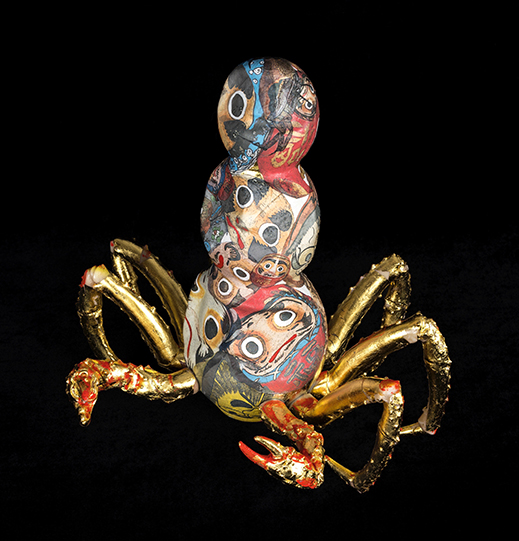 |
|
TORIPURUDARABADARUMA (Triple King crab Daruma) (2020), soft vinyl figure, urethane foam, papier-mache daruma, acrylic, mineral pigments, foil, 345 x 360 x 300 mm. Photo by Hiroshi Noguchi |
On the opening day of the MUGEN exhibition Kozaki graciously took the time to sit down and talk about his work, particularly in the context of these trying times. The following is my translation of our conversation.
▶ I see a lot of stringed instruments in your recent paintings here -- not just Japanese and Chinese lutes, but mandolins and even electric guitars! Are you a musician?
(Laughs) Well, I did play in a band a long time ago.
▶ Your methods and motifs have something in common with the collage work of the Surrealists. Is that one of your influences?
When I started out studying oil painting at university, I encountered Surrealists like Dali and Ernst, whom I really liked. Tracing their style back to its roots, I arrived at Bosch in the 15th century -- panoramic views populated by people that look like plants, creatures with human traits, humans tormented by demons. There seemed to be elements of different cultures shuffled together in ways that I found very interesting. They reminded me of works in Japan -- Nanban screens, Rakuchu rakugai zu panoramas -- that mix cultures like that. Japan itself is a hybrid culture that absorbed much from the Asian continent. There is tension and power in this mix.
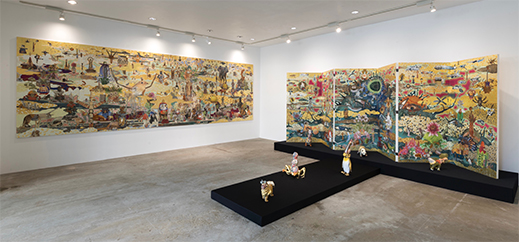 |
|
Installation view of MUGEN at the Art Front Gallery, showing the two large screen paintings and the "chimera" sculptures. Photo by Hiroshi Noguchi |
▶ Many of your works are titled TOUGEN, suggesting a kind of utopia, but they have a dark, sinister element as well. What do you want these collage-like, mixed-culture motifs to convey?
Basically, they are symbols of human desire. Chimeras [hybrid organisms created in recent biological experiments] are a product of desire -- the devil's work if you will, human desire taken to an extreme. Gold, too, represents desire: it glitters beautifully, but drives people mad.
▶ So the gold leaf of Edo-era screen paintings like the Rakuchu rakugai zu might symbolize luxury and the human desires prevalent in those days? Are your rocket ships and genetic mutants symbols of contemporary desires?
Yes. Genetic engineering has made the chimera a reality, and advances in rocket technology seem only to lead to international competition in space. Are these developments really necessary?
▶ You grew up in Futaba, Fukushima, home to the nuclear reactors that melted down after the March 2011 earthquake. Did that event contribute to your concern about the Faustian bargains we make with modern technology?
My works are not a direct statement about nuclear power. But personally, 2011 was a kind of turning point for me. Until then I, like most people, had gone along with the agenda of desire. So it is an influence in my work, but not one I have clearly thought out. The events of 2011 changed my way of thinking to some degree, but I'm not sure it changed how I paint. If anything, it was the other way around -- it demonstrated to me why I was doing what I was already doing.
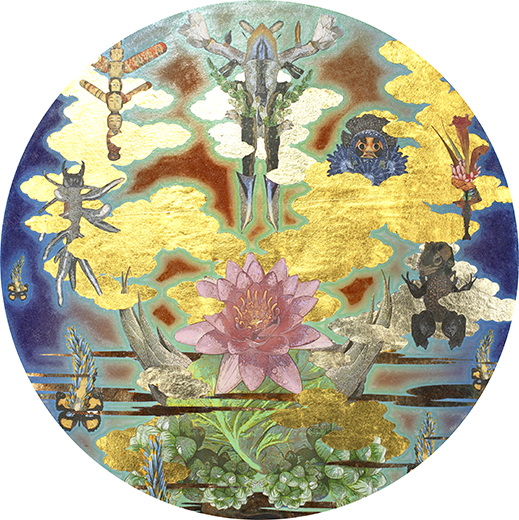 |
|
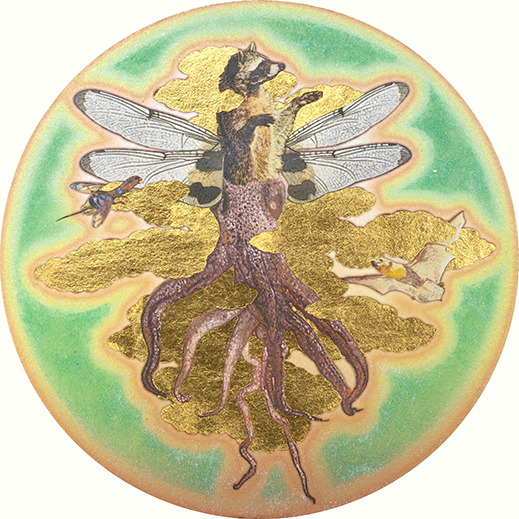 |
|
|
|
|
Flower man (2020), foil, mineral pigments, acrylic, hemp paper, panel, 500 x 500 mm
|
|
HANETANUKIDAKO (wing-raccoon-octopus) (2020), foil, mineral pigments, acrylic, hemp paper, panel, 250 x 250 mm |
▶ You now live in Yamagata, in Japan's northeastern Tohoku region, and your work is full of Tohoku-related motifs. Do the ghosts and goblins of Tohoku folklore also suggest something about human nature?
I think they represent things deep inside us that we can't talk about -- private prayers, family secrets, customs like obasute [the abandoning of the elderly to die in the mountains, once practiced in some impoverished communities]. These are fascinating things because they are so ningen kusai, so human -- literally, they stink of humanity. I find the same quality in the work of Bosch and Breughel.
▶ Could we say that the "stink of humanity" is an overarching theme of your work?
(Laughs) Sure! The chimera is an example of living things whose purpose is not clear. It's like a portrait in which the painter has depicted his subject's ugly side, not just the desired one.
▶ So you see the chimera as a kind of technology for its own sake, without purpose?
Chimeras are like pastiches of those cute yuru-kyara cartoon characters that government entities create as an endearing face for their ambitions. They represent our tendency to put the cart before the horse.
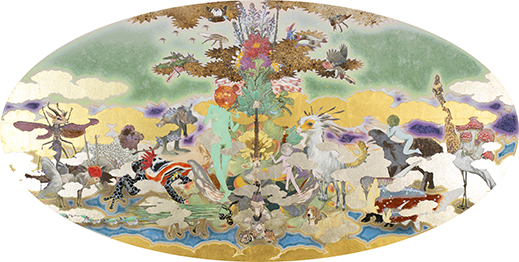 |
|
Tree of world -dialogue- (2020), foil, mineral pigments, acrylic, hemp paper, panel, 600 x 1200 mm |
▶ Have your themes, or objectives, changed over the four years since your last show here?
When I moved to Yamagata, I found new inspiration from the practices of yamabushi mountain ascetics there, and from the local osawabutsu [sculptures that blend Buddha figures with natural formations worshiped by yamabushi]. I'm inspired by many things in Tohoku. But my recent work has also been affected by the corona pandemic. When our very lifestyle becomes a risk, what can one individual do? We can't travel freely, and the Internet is not enough to make us fulfilled. I've been searching for images that can serve as a common language that humans can enjoy together.
▶ When you paint these works, do you plot out the motifs in advance, or do they come to you as you go along?
Both. This Surrealist approach of juxtaposing disparate images allows me to experience an element of surprise. I like to try out various ways of mixing and matching Eastern and Western motifs. I also borrow ideas from sources like the Shan hai jing ["Classic of Mountains and Seas," an ancient Chinese work], which is full of pictures of mythical creatures with several heads on a single body, spiders with human faces, that sort of thing. One large painting in this show [MUGEN -Tree of life-] is built around a "world tree," a huge plant representing the life of the world. The world tree or tree of life is a universal motif that people everywhere can relate to. With the coronavirus, we are in an age when nature, humanity, the Earth -- all of this must be dealt with as one. By painting these fusions of diverse phenomena, I'm hoping to offer something that resonates with people across national boundaries, regardless of differences in race or culture.
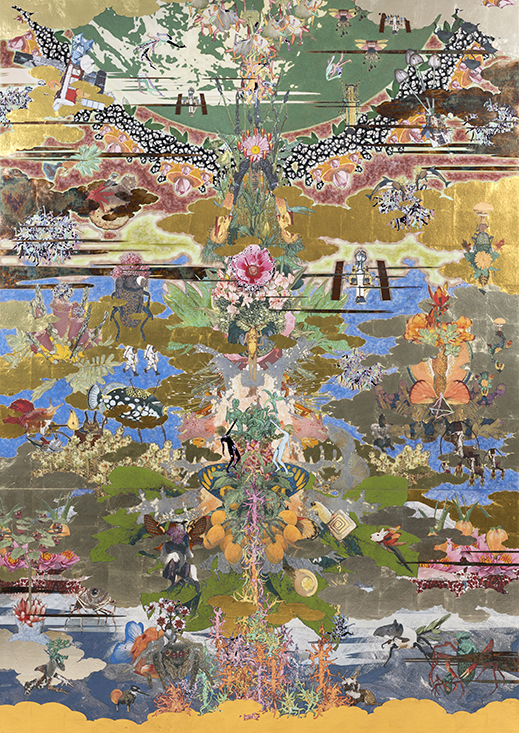 |
|
MUGEN -Tree of life- (2020), foil, mineral pigments, acrylic, hemp paper, panel, 2400 x 1700 mm. Photo by Hiroshi Noguchi |
▶ In your works here four years ago, I was struck by the amount of Buddhist imagery. Is that a significant motif for you?
Not specifically because it is Buddhist. But I titled this show MUGEN, meaning a dream or vision, to evoke the transience of this world, or human life, which I am trying to express in these pictures. That is certainly a Buddhist concept, but it is actually borderless, shared by many religions. Up to around four years ago, I think I was trying to convey my experiences in the mountains of Yamagata in close-up. This time I wanted to express a broader perspective. People viewing these works overseas sometimes focus a bit too narrowly on the Buddhist imagery.
▶ Well, many people in the West are fascinated by Buddhism, Zen, temples and the like.
It's a kind of Orientalism, perhaps part of a fixation with the exotic in other cultures.
▶ Still, the fact that motifs like Buddhas and kokeshi dolls are familiar to Western viewers may make it easier for them to absorb your other, less familiar images.
I hope so! (Laughs)
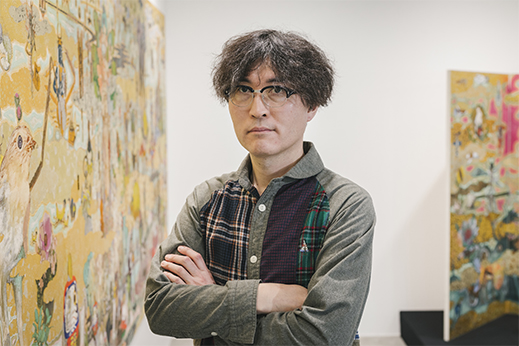 |
|
Masatake Kozaki at the Art Front Gallery, October 2020. Photo by Kohei Hara |
All works by Masatake Kozaki; all images by permission of Art Front Gallery. |
 |
| Masatake Kozaki: MUGEN |
| 23 October - 22 November 2020 |
| Art Front Gallery |
Hillside Terrace A, 29-18 Sarugaku-cho, Shibuya-ku, Tokyo
Phone: 03-3476-4869
Hours: 12 noon to 7 p.m. Wednesday to Friday, 11 a.m. to 5 p.m. Saturday and Sunday; closed Monday and Tuesday
Access: 5 minutes' walk from Daikanyama Station on the Tokyu Toyoko Line
|
|
|
|
| |
 |
Alan Gleason
Alan Gleason is a translator, editor and writer based in Tokyo, where he has lived for over 30 years. Since 2006 he has edited artscape Japan and written the Here and There column, as well as translating the Picks reviews. He also edits and translates works on Japanese architecture, music, and theater. |
|
|
|
|
|
|
|
|
|
 |
|